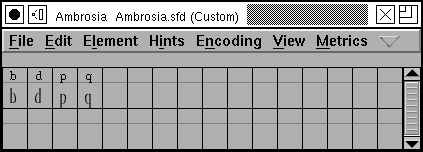Groups of Glyphs
A group is a collection of glyphs. It may be any collection that appeals to you. My expectation is that groups will be used to collect glyphs which are visually associated (in some way) close together so that they may be examined and changed without the visual clutter of the rest of the font. So you might make a group that consisted of "b d p q" which often have similar shapes, or in a Korean font you might wish to look at all sylables with a give cho-sung.
 FontForge
treats groups like baby encodings. In the image at left, it is displaying
a font showing only the glyphs "b d p q". The order the glyphs are mentioned
in the group is the order in which they will be displayed in the fontview
-- and, like an encoding the group may be compaced so there are no empty
holes for missing glyphs (so if the group had contained "b d p uniAC00 q"
and the font was missing uniAC00, the display would be exactly the same)
or uncompacted with holes.
FontForge
treats groups like baby encodings. In the image at left, it is displaying
a font showing only the glyphs "b d p q". The order the glyphs are mentioned
in the group is the order in which they will be displayed in the fontview
-- and, like an encoding the group may be compaced so there are no empty
holes for missing glyphs (so if the group had contained "b d p uniAC00 q"
and the font was missing uniAC00, the display would be exactly the same)
or uncompacted with holes.
Glyphs in a group may be specified by glyph name, by unicode code point or
by a range of unicode values. The examples above all used glyph names. A
unicode code point looks like "U+XXXX" (where XXXX indicates a hex number).
Occasionally fonts will use this notation to name their glyphs (they should
not, but some do), that should not be a significant problem because such
glyphs should have the obvious unicode code points and so will still match.
A range of unicode code points looks like "U+XXXX-U+YYYY" (XXXX < YYYY).
A groups are heirarchical. A group may either contain a list of glyphs, or a list of sub-groups. (If you display (in the fontview) a group which contains subgroups you will see all glyphs in all sub-groups. A glyph may occur more than once if that is desirable. So a group could contain "A A A A" and the fontview would show four copies of "A" (I'm not sure why you'd want to do that, but you could). As you design your groups you can ask fontforge to check so that you do not inadvertently put the same glyph in more that one group (or in the same group twice).
 Display
by Groups
Display
by Groups
The Display by Groups dialog is shown in the screen shot at right. The top-level group is called "Groups" it has two children, one called "Vowels" which is a terminal group and contains the glyph names of the latin vowels, the other called "consonants" which itself contains three subgroups.
Any group with children will have (to the right of its name) a square box containing either a "+" or a "-", clicking on this box will either expand all the sub-groups of the group, or contract them into invisibility (here all are expanded).
Clicking on a group's name will select it (clicking again will deselect it).
Here groups "ascenders" and "descenders" are selected. If you were to press
[OK] then the fontview would show the glyphs associated with
"b d f h k l t g j p q y" in that order.
Underneath everything is a check box you may use to specify whether you want
the results compacted or not.
 Define
Groups
Define
Groups
This dialog is a bit more complicated than the previous one. It again contains the group list at the top of the dialog, but here only one group at a time may be selected, and information about it is displayed in the bottom part of the dialog and is subject to change.
You can [Delete] the group (this also deletes any subgroups).
If the group contains no glyphs then you may add sub-groups to it. Every
group has a name. If the group contains no subgroups you may add glyphs to
it.
The [Set] and [Select] buttons interact with the
selection in the associated fontview. [Set] sets the glyph list
to the glyphs selected in the fontview, while [Select] changes
the selection to the glyphs specified in the glyph list. Normally glyphs
are entered into the glyph list by <*>Name, but you can
change the radio button to <*>Unicode and glyphs will
be entered as U+0067 U+006A U+0070-U+0071 U+0079.
If you select [*]No glyph duplicates then ff will prevent you
from entering the same glyph name (or unicode code point) twice (ff will
allow you to enter "A" and U+0041 -- because I'm lazy and this is harder
to check for and less likely to occur). If you set this in a parent group
then there can be no glyph duplicates among any of its
children.